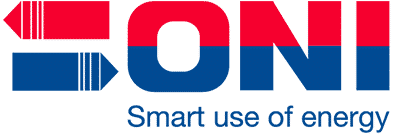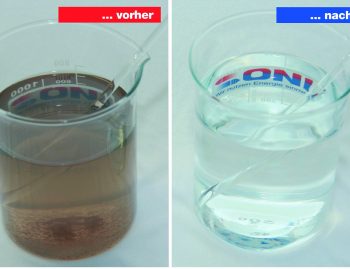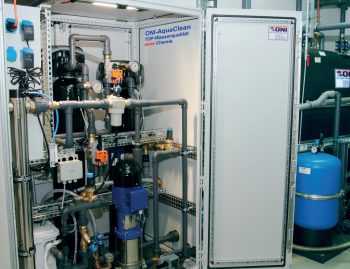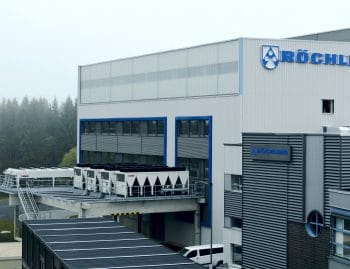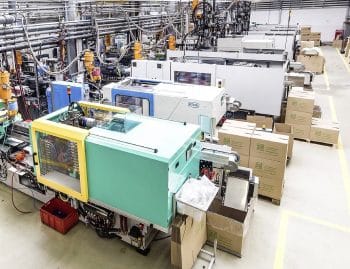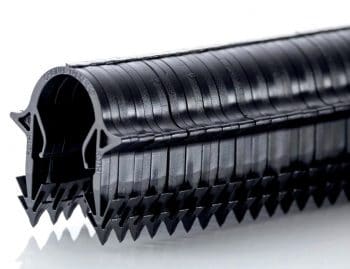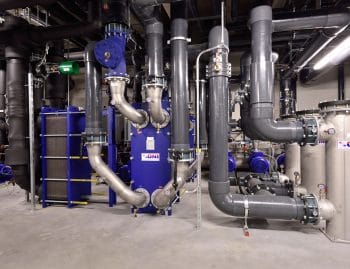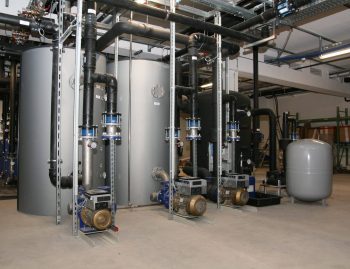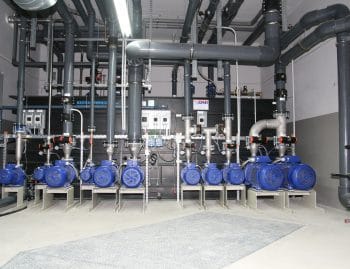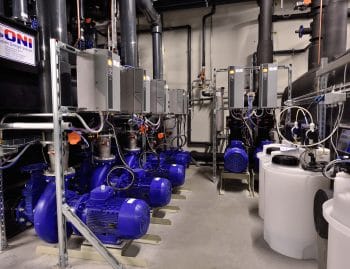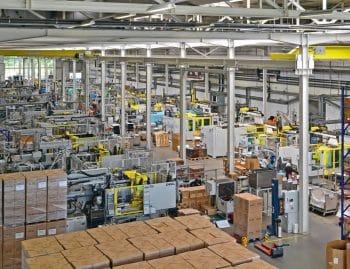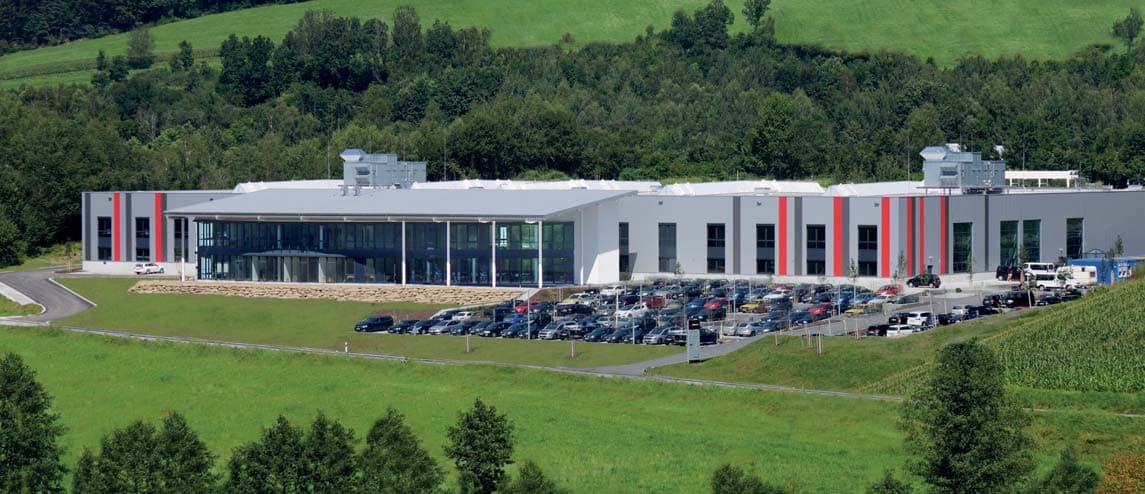
For decades, the name AVS Ing. J.C. Römer GmbH has stood for high-quality plug-in and screw connections, solenoid valves and sensors. With innovative product solutions, highly specialized manufacturing processes, a high-performance and highly motivated team, the company has developed into one of the most successful companies in the industry. In the core business successfully, one recognized however also that low energy costs are of special importance in an energy-intensive enterprise for the future safety device.
For this reason, the construction of the new production site in Grafenau with a usable floor space of more than 15,000 square meters was based on a technology that makes an optimized use of energy possible. The energy concept implemented in it can also be described as an outstanding example in terms of energy efficiency and environmental awareness.
The AVS Ing. J.C. Römer GmbH with the locations Königsdorf near Munich, Grafenau in the Bavarian Forest and Langenberg in the Erzgebirge is an extremely innovative and successful classic family business. Founded in 1970 by the engineer Joachim C. Römer as a one-man business, the company has grown over the years into a company with today more than 260 employees. The company develops, designs and manufactures components for connecting hoses and pipes or for conveying, distributing and shutting off gaseous and liquid media. Components are plug-in and screw connections, solenoid valves and sensors which are used, for example, in machine and plant construction, in automatic machines for the food industry, in telecommunications technology, in medicine and laboratory technology, in water treatment or in heating and cooling systems. The products have a high manufacturing quality and are particularly suitable for the food and medical sectors due to their conformity with certificates (NSF) and standards.
The vertical range of manufacture and the quality standards in all areas of the company are absolutely impressive. This can only be demonstrated by the uniquely broad knowledge potential of the Römer team, which is a prerequisite for many unique selling points of the company. For example, the company specialises in manufacturing plastic and metal parts, which are used in the end products, in an enormous variety of materials, taking into account the highest end user requirements and in line with the latest market requirements in the best possible quality. In addition to manufacturing products in large quantities, the company also implements customer-specific special solutions in small quantities, from the initial idea through to series production.
High efficiency target
"With the decision to build the new production site in Grafenau, we have set high targets for project planning with regard to energy efficiency. We wanted all possibilities for energy saving to be examined with regard to their sustainability, economic efficiency and environmental aspects and to be implemented with a correspondingly positive assessment. For the realization of the project, we have brought the energy saving specialist ONI-Wärmetrafo GmbH to the table for the implementation of the energy media supply. The result is a concept that is modern from our point of view and outstanding in terms of energy efficiency, which secures us sustainably low energy consumption and with which we are optimally equipped for expected energy price increases," is how Managing Director Peter Podhorodeski describes the AVS management's approach for the implementation of the new building project in Grafenau.
The quality demands on AVS' own products are very high. This results in production conditions that are clearly defined and must be ensured at all times. These include, for example, constant room conditions, which are essentially determined by room air quality and temperature and can only be ensured by appropriate energy input in the heating sector. Since the resulting energy costs for heating rooms and processes represent a significant burden factor for operation, it is clear that the intensive search for suitable energy sources that can replace primary energy sources such as natural gas and heating oil has high priority. At AVS, therefore, all possible waste heat sources were already evaluated with regard to their potential and useful temperature level during the planning phase and their best possible mode of operation was determined. For the supply/use concept, low temperature was set and system parameters in all other areas were lowered to the minimum level in order to ensure the best possible conditions for maximum use of the primary energies used or their multiple use through the use of heat recovery systems.
Heating determines cooling
The heating supply of an industrial building usually requires an output-adapted boiler system, which in the heating period intersperses some primary energy in the form of heating oil or natural gas. With AVS, the energy cost problem is solved efficiently and simply by a clever energy concept. The energy used is not used once, but twice if possible. The corresponding systems are configured accordingly. Specifically, cooling water circuits and the primary heating water circuit were designed for a temperature spread of 30/35 degrees Celsius. The cooling water supply for the production machines, cooling machine and compressed air generation was adapted accordingly. This temperature design also benefits the generation of heating heat via a boiler system, which is required if the amount of waste heat is insufficient to cover the heating demand.
In this specific case, gas condensing technology is used in the boiler technology. With this technology, targeted undercutting of the dew point at the heat exchanger surfaces ensures that the moisture contained in the flue gas precipitates and thereby releases the condensation heat to the heating water. The efficiency that can be achieved with such boilers at a heating water return temperature of 30 degrees Celsius is about ten to twelve percent higher than that of a conventional steel boiler.
The temperature spread of 30/35 degrees Celsius is not only ideal for cooling machines, systems and processes, but is also ideally suited for heating. All heating surfaces used for room heating or for heating supply air in ventilation systems are designed for this spread and thus enable the energy already used to be reused via a heat recovery measure.
"With this heating concept from ONI, we can massively reduce the heating energy costs that arise when conventional technology is used. In view of further energy price increases to be expected, this technology cannot be rated high enough," says Managing Director Robert Süß, drawing a partial balance for this area.
Little energy for a good climate
Sensitive production areas in which high-quality products are manufactured require defined room ventilation, which is inevitably energy-intensive. In order to achieve the highest possible energy efficiency of the ventilation system, the large central ventilation systems were each specially equipped with an air capacity of around 45,000 cubic metres per hour. In the first stage, these units ensure that the waste heat from the exhaust air is used to preheat the supply air. For this purpose, the units are equipped with rotating storage masses which are installed in a two-part duct. In one duct the exhaust air is guided and in the second duct the supply air is guided according to the counterflow principle. Before the exhaust air is discharged into the atmosphere, it must pass through the air-permeable heat transfer medium or storage mass and, depending on the temperature difference and dwell time, emits a quantity of heat there. After the surface has passed the exhaust air cross-section, it enters the supply air duct and transfers the amount of heat absorbed from the exhaust air to the supply air. The so-called heat recovery efficiency or thermal efficiency of the heat recovery achieves values of up to 80 percent. Heating above and beyond this takes place via a heat exchanger that uses free cooling water heat as a heating medium.
Summary
"You need the right people at the table for advice and project planning and on the construction site for smooth project implementation. If you add up the time from the first consultation to the turnkey handover of the entire plant, add the smooth project flow and the convincing energy saving result, you get an outstanding result, which speaks for the excellent cooperation with the experts of ONI-Wärmetrafo GmbH. Together, we have implemented a project that ensures that our energy costs remain at an absolute minimum through the use of state-of-the-art, energy-saving technology," says Christoph Cegla, Managing Director of AVS Ing. J.C. Römer GmbH, in his positive assessment of the implementation of the project.
